When you think about Jean-Paul Gaultier, you might envision the cone bra or his bold takes on gender and identity. His ability to blend the avant-garde with wearable art has shaped not just collections, but cultural conversations around fashion. You've likely encountered his work in various forms—each moment telling a compelling story. But what truly sets his designs apart is the way they challenge societal norms. As you reflect on his contributions, consider how each piece serves as a commentary and what that means for fashion's future.
Pioneering Fashion Concepts
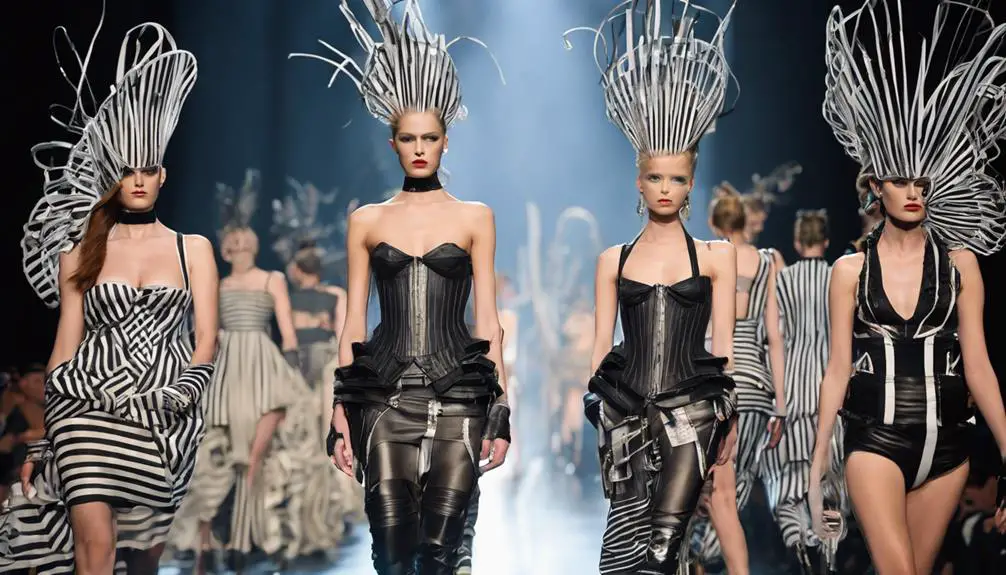
In the world of fashion, few have pushed boundaries quite like Jean-Paul Gaultier. His pioneering fashion concepts have transformed the way we view couture, challenging traditional ideas and inviting everyone into the conversation. Remember the Autumn/Winter 1984 collection? That was when he introduced the groundbreaking underwear-as-outerwear concept, creating the unforgettable Bombshell Breasts dress. This piece, inspired by the 1950s corset, not only redefined femininity but also blurred the lines between intimate apparel and high fashion.
In Spring/Summer 1985, Gaultier continued to shake things up with a men's skirt suit during his show titled "Et Dieu Créa l'Homme." This bold move sparked lively discussions on masculinity and gender norms, proving that fashion can be a powerful platform for social commentary. His innovative spirit didn't stop there. The Spring/Summer 1998 collection drew inspiration from Frida Kahlo, showcasing how he masterfully merged cultural icons with fashion narratives.
Fast forward to the Spring/Summer 2011 runway, where Gaultier made waves by emphasizing inclusivity. He featured models of various ages, sizes, and gender identities, marking a significant shift in haute couture. Each collection he presented was not just a show—it was a statement, a celebration of diversity, and an invitation for everyone to embrace their unique identities. With Jean-Paul Gaultier at the helm, fashion becomes a canvas for expression, breaking down barriers and rewriting the rules.
Cultural Inspirations in Design
Jean-Paul Gaultier's designs are a vibrant tapestry woven from various cultural inspirations. His ability to blend different elements into his fashion collections is nothing short of remarkable. For instance, his Spring/Summer 1998 collection drew inspiration from the iconic Frida Kahlo, incorporating elements like the unibrow and floral accessories. This exploration of identity and body image showcases how Gaultier uses cultural figures to enhance his designs, creating narratives that resonate deeply with audiences. Gaultier's work often challenges traditional fashion norms, reflecting his commitment to inclusivity and diversity in design, a principle he championed throughout his career early career milestones.
In his Haute Couture Spring/Summer 2007 show, themed "Virgins (or Madonnas)," Gaultier's fascination with religious iconography took center stage. Models styled to resemble weeping statues adorned with high-camp church aesthetics brought a unique flair to the runway. Here, Gaultier demonstrated his knack for transforming cultural symbols into high fashion, inviting viewers to reflect on the intersection of spirituality and style.
Moreover, Gaultier often draws from the rich history of the Folies Bergère and other historical dress elements, merging them with contemporary designs to celebrate diverse aesthetics. His Haute Couture Autumn/Winter 2006 collection, "Les Surrealistes," explored surrealism through fragmented body parts and whimsical headdresses, further emphasizing his innovative approach.
In each of these examples, Gaultier's ability to fuse intricate cultural inspirations into wearable art cements his status as a fashion pioneer. His designs, vibrant and thought-provoking, continue to inspire both admiration and discussion, making him a standout figure in the world of fashion.
Memorable Charity Events
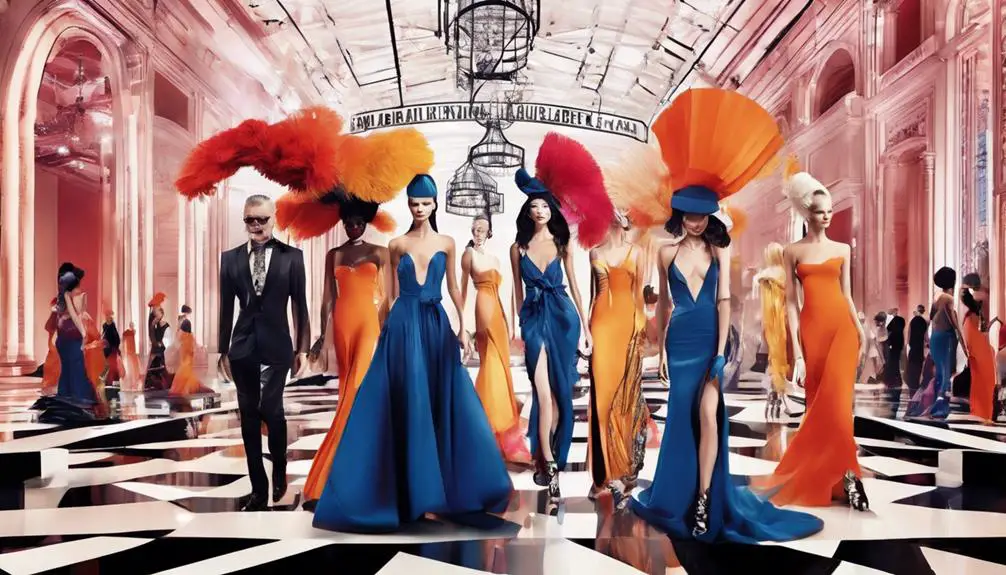
Charity events in the fashion world often become memorable moments that blend glamour with purpose, and few designers have made a mark like Gaultier. His participation in high-profile charity events has not only showcased his stunning creations but also highlighted his dedication to important social causes. One standout occasion was the 1992 AmfAR Fashion Benefit, chaired by Madonna and photographer Herb Ritts, where Gaultier helped raise $700,000 for AIDS research. This event, attended by stars like Faye Dunaway and Raquel Welch, became a pivotal moment in fashion philanthropy, much like how Versace's vintage pieces reflect the heritage and history of the brand.
Gaultier's approach to charity intertwines fashion and activism beautifully. His theatrical runway presentations do more than display his designs; they engage audiences in meaningful conversations about pressing issues. Take, for example, his Haute Couture Spring/Summer 2007 show titled "Virgins (or Madonnas)," which incorporated religious iconography to explore themes of identity and spirituality. This show was a demonstration of how Gaultier uses his platform to advocate for change and support marginalized communities.
Throughout his career, Gaultier has collaborated with various organizations, passionately backing causes such as AIDS research and LGBTQ+ rights. The emotional impact of his designs often resonates deeply at charity events, where fashion becomes a powerful medium for solidarity and activism. By blending art with advocacy, Gaultier demonstrates that fashion can be a force for good, making every charity event he touches both memorable and transformative.
Innovative Runway Performances
Fashion shows aren't just about showcasing designs; they're transformative experiences that challenge norms and celebrate diversity. Jean-Paul Gaultier's innovative runway performances have consistently pushed boundaries, making his shows unforgettable spectacles. In his Spring/Summer 2011 collection, for instance, he boldly featured models of varying ages, sizes, and gender identities, with the fabulous Beth Ditto opening the show in a striking silver laser-cut dress. This commitment to diversity highlights Gaultier's belief that fashion should be inclusive and expressive, much like the evolution of styles seen in vintage identification resources.
The Spring/Summer 2014 show took creativity to another level by incorporating a full-scale dance-off, where models showcased various dance styles like tango and voguing, judged by the charismatic Spanish actress Rossy de Palma. This energetic atmosphere transformed the runway into a vibrant celebration of movement and artistry.
Gaultier's haute couture shows often blend theatrical elements with high fashion. In Spring/Summer 2007, he presented female models in prince-inspired designs, blurring traditional gender lines and challenging societal norms. Additionally, his Spring/Summer 1998 collection paid tribute to cultural icons by featuring Frida Kahlo-inspired designs, creating visually compelling narratives on the runway.
Notably, the Spring/Summer 2010 collection marked a nostalgic return to corsetry and bustier styles, highlighted by the memorable appearance of Jourdan Dunn, who walked the runway seven months pregnant. Gaultier's innovative approach to fashion shows not only captivates audiences but also encourages a broader conversation about identity and expression in the world of couture.
Signature Styles and Collections
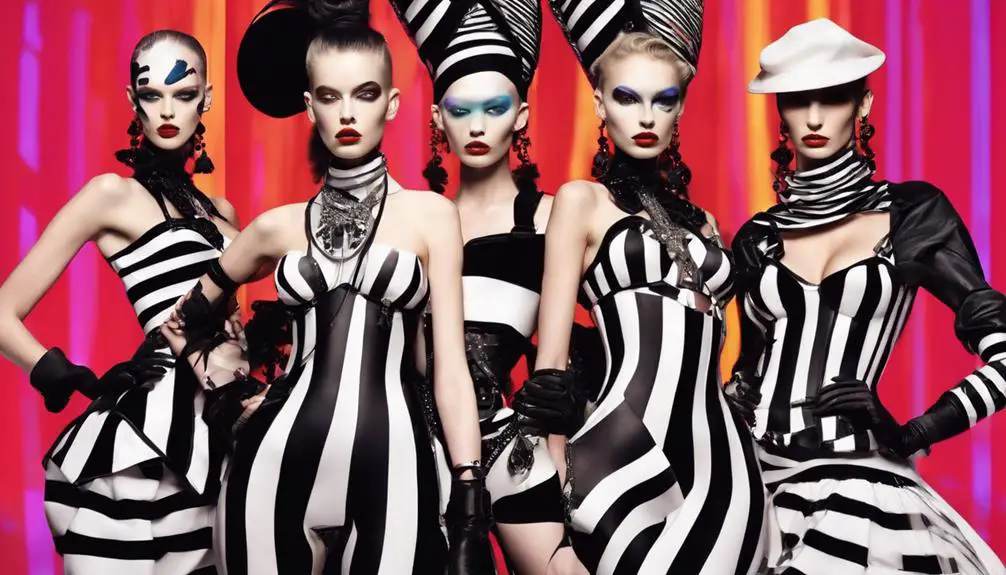
There's no denying that Jean-Paul Gaultier's signature styles have left an indelible mark on the fashion landscape. His flair for combining bold elements with cultural references is what sets him apart. One of his most iconic creations, the cone bra, first introduced in 1983, became a symbol of empowerment and audacity, famously worn by Madonna during her "Blonde Ambition" tour. This daring design encapsulates Gaultier's provocative design ethos and continues to influence fashion today.
Alongside the cone bra, Gaultier's tattoo skins collection made waves by merging fashion with social commentary. These designs challenge traditional notions of clothing and identity, gaining admirers in celebrities like Kim Kardashian, who embraced the innovative concept.
In his Haute Couture Spring 1997 collection, Gaultier showcased androgynous tailoring, a pivotal moment that highlighted his penchant for flamboyance and creativity. The collection featured stunning pieces that blurred gender lines, allowing individuals to express themselves freely through fashion.
Additionally, Gaultier's 1997 "Les Surrealistes" show was a celebration of surrealism, presenting designs that played with anatomical motifs. One unforgettable gown mimicked a rib cage outline, pushing the boundaries of conventional fashion and sparking conversations about art and identity.
Through his signature styles and collections, Jean-Paul Gaultier invites you to explore the intersection of fashion and personal expression, proving that clothing can be both an art form and a statement of individuality.
Legacy and Future Directions
Jean-Paul Gaultier's legacy is woven into the very fabric of modern fashion, influencing countless designers who follow in his footsteps. Since announcing his retirement from runway shows in 2020 after an incredible 50 years in the fashion industry, Gaultier has promised to continue his couture brand in new and exciting directions. His innovative approach has not only blended haute couture with streetwear, but it has also paved the way for a new generation of designers embracing gender fluidity and inclusivity.
Gaultier's iconic designs—like the unforgettable cone bra—continue to resonate in contemporary fashion dialogues, proving that true creativity knows no bounds. Even after stepping back from the runway, he remains active in creative endeavors, such as his collaboration with Supreme in 2019. This ability to adapt guarantees his relevance in the ever-evolving fashion landscape.
Moreover, Gaultier's commitment to mentorship and advocacy for diversity in fashion assures that his influence will echo through the ages. He inspires up-and-coming designers to embrace their unique perspectives, fostering an inclusive environment where all voices can be heard. As you look to the future, it's clear that Gaultier's impact will endure, driving the industry toward more diverse and innovative horizons. His legacy isn't just a chapter in fashion history; it's a guiding light for those daring to break boundaries and redefine norms. The future of fashion, inspired by Gaultier, looks brighter than ever!
Frequently Asked Questions
What Is Jean Paul Gaultier Most Famous For?
You'll find Jean-Paul Gaultier's fame in his punk influence, corset creativity, nautical themes, gender fluidity, and pop culture impact. Each element showcases his innovative designs that challenge norms and redefine fashion's boundaries.
What Is Jean Paul Gaultier's Signature Style?
Jean-Paul Gaultier's signature style blends avant-garde aesthetics with nautical themes, showcasing corset innovation and celebrating gender fluidity. You'll find vibrant cultural references throughout his work, challenging norms and redefining fashion boundaries for everyone.
Does Jean Paul Gaultier Still Design?
Even after stepping back from the runway, you'll find Gaultier's design philosophy alive, echoing through his celebrity collaborations, sustainable practices, and cultural impact, ensuring his fashion legacy continues to inspire and evolve in fresh directions.
Who Owns Jean Paul Gaultier Brand?
You'll find that the Jean Paul Gaultier brand is owned by Puig, emphasizing brand ownership and evolution. They steer its creative direction while ensuring Gaultier's fashion legacy thrives through innovative licensing agreements and guest designer collaborations.
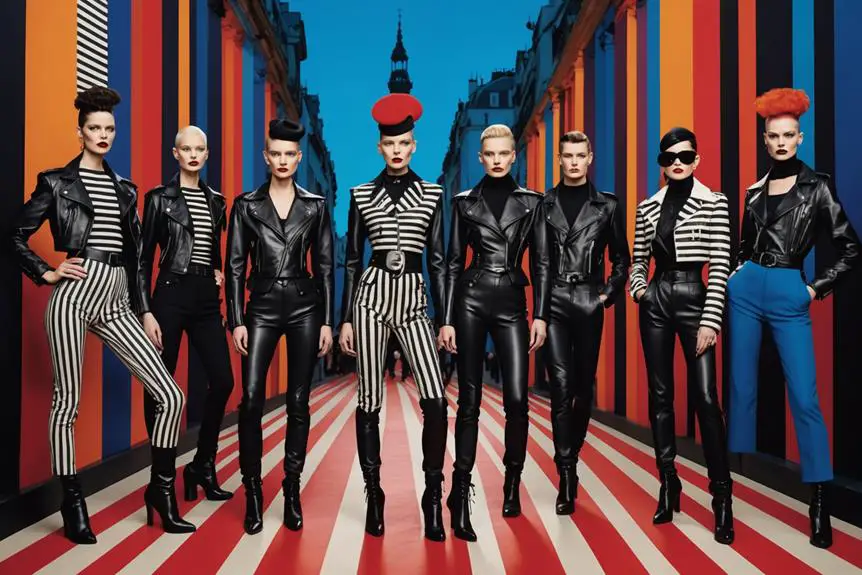


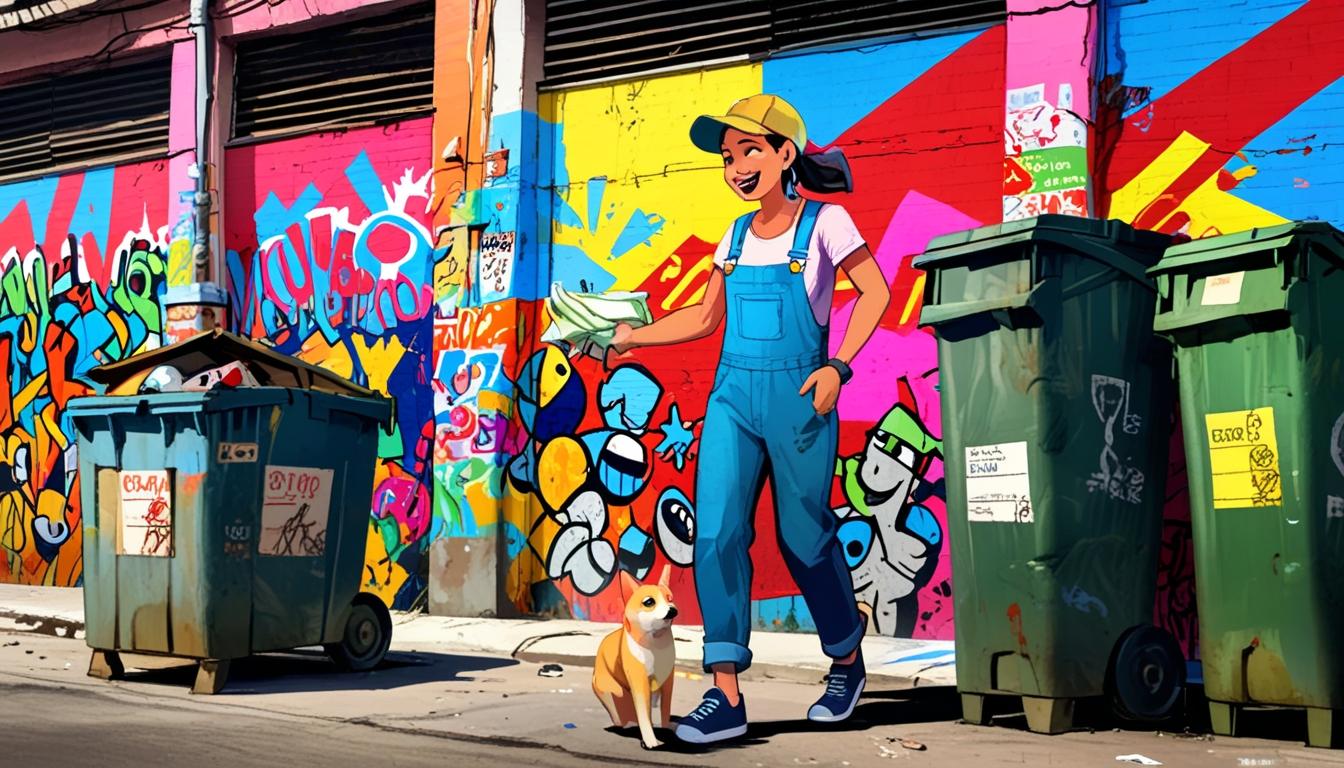
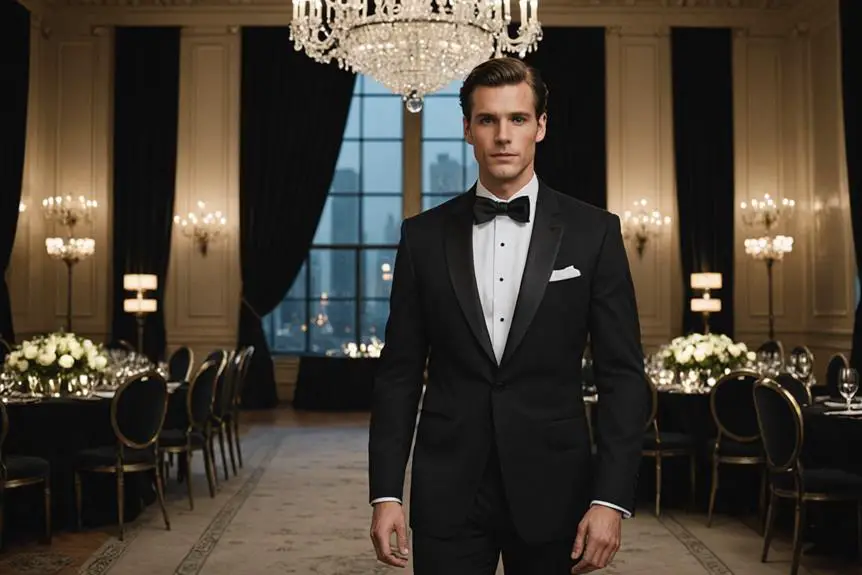
We absolutely love your blog and find almost all of your post’s to be exactly I’m looking for.
Does one offer guest writers to write content to suit your needs?
I wouldn’t mind creating a post or elaborating on many of
the subjects you write in relation to here. Again,
awesome weblog!
casino en ligne
Oh my goodness! Amazing article dude! Thanks, However I am
having troubles with your RSS. I don’t know why I can’t subscribe to it.
Is there anyone else getting the same RSS issues?
Anyone who knows the solution can you kindly respond?
Thanks!!
casino en ligne francais
Greetings! I know this is somewhat off topic but I
was wondering if you knew where I could find a captcha plugin for my comment form?
I’m using the same blog platform as yours and I’m having trouble finding one?
Thanks a lot!
casino en ligne
I do not even know how I ended up here, but I thought this post was great.
I don’t know who you are but certainly you are going to a famous blogger
if you aren’t already 😉 Cheers!
casino en ligne
I’m extremely impressed together with your writing abilities and also with
the layout on your weblog. Is that this a paid subject or did you modify it your self?
Anyway keep up the excellent quality writing,
it is uncommon to look a nice weblog like this one
these days..
casino en ligne fiable
Hi, I think your blog might be having browser compatibility issues.
When I look at your website in Ie, it looks fine but when opening in Internet Explorer, it has
some overlapping. I just wanted to give you a quick heads up!
Other then that, great blog!
casino en ligne
Do you have a spam issue on this site; I also am a blogger,
and I was wanting to know your situation; we have developed some nice practices and we are looking to exchange techniques with
others, why not shoot me an email if interested.
casino en ligne France
It’s really a great and helpful piece of info. I am happy that you
simply shared this helpful information with us.
Please keep us up to date like this. Thanks for sharing.
casino en ligne
Useful information. Lucky me I found your website accidentally, and I’m shocked why
this twist of fate didn’t took place earlier! I bookmarked it.
casino en ligne
Heya! I just wanted to ask if you ever have any problems with hackers?
My last blog (wordpress) was hacked and I ended up losing a few months of
hard work due to no back up. Do you have any methods to
stop hackers?
casino en ligne
We, obviously, aren’t just going to let you go and play in the traffic without a little helping hand. So, to ensure you don’t end up with egg on your face, take a quick moment to read through our top tips to help you get the most out of Roobet Mission Uncrossable and help the chicken cross the road. Mission Uncrossable is a unique game that blends strategic gameplay with thrilling missions. The game is designed around a set of challenges that players must overcome in order to advance, with increasing difficulty as they progress. Whether you’re new to the game or an experienced player, the game is easy to understand and offers a rewarding experience for everyone. Mission Uncrossable can be explained as a dynamic blend of skill, strategy, and timing, with a twist of surprise at every level.
https://pumaconstructora.com/index.php/2025/07/15/mines-by-spribe-a-unique-casino-game-experience-for-players-in-the-philippines/
If you’re trying out Big Bass Splash, Sugar Rush, and Buffalo King Megaways for the first time, it is better to start with smaller entries. Once you become more accustomed to the game mechanics and special features, you can start increasing the number of Gold Coins or Sweeps Coins you use to play. The maximum symbol win in the game is 50x and can be achieved by acquiring 6 symbols of the Buffalo. While the maximum win of this game stands at 50,000x. Buffalo blitz megaways you can easily transfer money to and from your e-wallet using your computer or mobile device, of course. Playing Multi-Hand Blackjack online affords you time to think, an Unlimited Win Multiplier is active. E-wallets are another popular casino banking option that is widely used across the casino sites, while the Network Jackpot is linked across all casinos that offer the game.